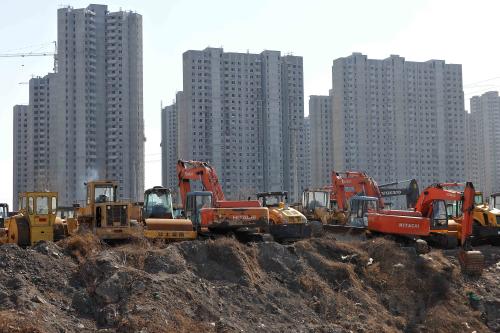|
 |
|
AFFORDABLE HOUSES: A community of housing under construction in Taiyuan, Shanxi Province (ZHAN YAN) |
In June 2011, the average house price in 100 Chinese cities was 8,856 yuan ($1,373) per square meter. Of these cities, house prices in 75 of them increased from the previous month. Zhengzhou and Luoyang in Henan Province, Changchun in Jilin Province, and Weifang in Shandong Province had the biggest month-on-month price hikes.
In the first half of 2011, Chongqing Municipality, and Fuzhou and Xiamen in Fujian Province saw the biggest increase in house prices over the same period last year, which stood at 30.1 percent, 33.69 percent and 25.07 percent respectively.
These figures from the China Index Academy, one of China's largest property research organizations, may explain the decision made by the State Council meeting chaired by Premier Wen Jiabao on July 12.
The decision required cities that had already implemented home purchase limits continue to carry out related policies, while second- and third-tier cities whose house prices increased rapidly carry out necessary policies to limit home purchases.
According to a Xinhua News Agency report, the meeting pointed out one of the major problems in the real estate market is some cities still face great pressure of real estate price hikes and some cities have relaxed control of the real estate market.
Any indications of house price rebounds will certainly be stopped by the government. Possible house price rebounds in second- and third-tier cities, market rumors that home purchase limits will soon end and attempts to relax control of the real estate market by some cities caused this round of actions by the Central Government.
Imperative action needed
In April 2010, Beijing announced regulations allowing each family to buy only one extra home. This was the first policy limiting property purchases. Following Beijing, similar policies sprang up in Shanghai, and Guangzhou and Shenzhen of Guangdong Province, as well as nearly 40 other cities.
Under strict control, house prices in some cities have decreased on a yearly or monthly basis—but in some second- and third-tier cities, house prices are still soaring.
Figures released by the National Bureau of Statistics (NBS) show, from January to June this year, among the 70 large and medium-sized cities, the number of cities whose house prices rose above 5 percent year on year was 44, 45, 42, 38, 31 and 28, respectively, all in second- and third-tier cities. Compared with first-tier cities, second and third-tier city increases were much more threatening.
For example, in January this year, house prices in Yueyang of Hunan Province rose 22 percent year on year, the biggest of the 70 cities. In April, Dandong of Liaoning Province ranked first with a year-on-year increase of 11.3 percent. In May, house prices in Dandong, Urumqi of Xinjiang Uygur Autonomous Region and Qinhuangdao of Hebei Province all increased more than 8 percent.
Out of these 70 large and medium-sized cities, house prices have even soared six or 10-fold in the past five years.
| 